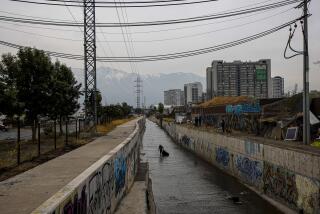Changing Lifestyles : 20th Century Takes a Slow Boat to Chilean Island : Ferry brings new prosperity, but farmers still use oxen for plowing and harvest wheat with hand scythes.
- Share via
HUAPI ISLAND, Chile — For many of the native Mapuche people on this once-isolated island in a southern Chilean lake, the dawn of the 20th Century came in October, 1991.
That was when a steel-hulled ferry began plying the deep blue waters of Lake Ranco between Huapi and the lakeshore city of Futrono, nearly 10 miles away.
The ferry has brought important changes for the island community of 600 people and, said Victor Anchimil, principal of the local school, “it has greatly improved the people’s quality of life.”
The islanders feel less isolated, explained Anchimil, a Huapi native. Incomes have increased as the ferry has helped farming families get their produce and livestock to market. A couple of tractors and a harvesting machine have been ferried to the island to lighten agricultural work. A sign of new prosperity is the rapidly increasing number of television sets.
And yet, in its final years, the 20th Century seems to be just dawning here.
Huapi residents still depend on horses or their own feet to move around the island’s 2,000 acres of green meadows and rolling hills. Most plowing is still done with oxen, and most wheat crops are harvested with hand sickles and scythes. The new TV sets run on car batteries because island homes still lack electricity.
In many ways, Huapi continues to exemplify the widespread underdevelopment of rural communities throughout the vast hinterlands of South America. But it also is a showcase for the kind of improvements that can come to an isolated community over a new road, a bridge--or in this case, a ferry.
Early in this century, the people of Huapi used dugout canoes to come and go between their island and the mainland. In recent decades, rowboats were the predominant form of transportation. A few boats had outboard motors.
Boating accidents were frequent. Sudden storms make Ranco’s waters treacherous for small craft.
“Many people lost their lives trying to go to Futrono in fragile boats,” Anchimil said.
Since the municipality of Futrono began operating the ferry in 1991, the number of boating accidents has declined sharply. And not only can Huapi people cross to the mainland more safely, they can take animals and more produce to the market there. The vessel can carry up to eight cows and 40 people.
Futrono now relies almost entirely on Huapi farmers for vegetables. The increased interdependence has brought a boom in intensive agriculture on the island.
The people of Huapi are among Chile’s estimated 500,000 Mapuches. They descend from an indigenous nation that once dominated southern Chile but whose domain has been reduced to a small fraction of their ancestral lands.
Few Indian groups in South America defended their land as long and as fiercely as the Mapuches. But the Chilean army finally conquered them in bloody fighting at the beginning of the 1880s, opening up southern Chile to outside settlers.
Today, most Mapuche communities are rustic and poor, like Huapi. The benefits of Chile’s economic development come slowly to these places but, like the ferry from Futrono, they do come.
“My grandfather traveled in a canoe,” recalled Jose Fernando Llancumil, chief of the traditional Huapi community.
But the ferry is not the only good thing that has come Huapi’s way in recent years.
The municipality and the Chilean government forestry agency, known as Conaf, have intensified a reforestation program on the island in the last three years. Last year, the program started a tree nursery, and the first 25,000 eucalyptus saplings are scheduled to be ready for planting in June.
The reforestation program is aimed not only at controlling erosion of bare hills but at providing islanders with building material and fuel. Around the mid-1900s, lumbering companies began cutting Huapi’s forest, opening more space for agriculture but changing the native way of life forever. In recent decades, more trees have been cut to make charcoal for cooking and heating, leaving the island almost completely deforested.
Since the 1980s, the municipality of Futrono has loaned island farmers money for fertilizer, to be paid back in produce. Proceeds from sales of that produce go to maintain the Huapi school.
The Kellogg Foundation of the United States donated $1,000 in 1991 for a small electric generator that supplies power to the school and the island health clinic.
Llancumil, the chief of the traditional Huapi community, said the German government development agency is planning a project to install windmill generators that will provide electricity for the whole island.
But for Llancumil, 53, not all change on the island is for the better. For example, the number of families that participate in traditional Mapuche religious rituals has declined sharply in recent years. Now, Llancumil said, only 38 of the island’s 120 families take part in the three-day annual pre-harvest feast, called Nguillatun.
“It’s because of the (Christian) evangelical religion that has come in here,” he said. “That is a foreign religion--it doesn’t belong here.”
Llancumil became Mapuche chief last year when the island’s previous chief, his cousin, joined an evangelical church. “Mapuche people don’t follow that evangelical religion,” he said.
Another problem is population pressure. As the native population has grown, family farms have been divided and subdivided until many young people do not have enough land to make a living. In the last five years, at least 10 families have moved off the island.
“The land is becoming too small,” said Chief Llancumil, who has 11 acres. “I have five children, and with those 11 acres, they won’t all be able to stay here.”
More to Read
Sign up for Essential California
The most important California stories and recommendations in your inbox every morning.
You may occasionally receive promotional content from the Los Angeles Times.













